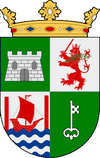| Elin V | |
|---|---|
| Elin V | |
| Elin V | |
| Queen of Álengiamark | |
| Reign | 30th December, 1463 - 3rd April, 1502 |
| Predecessor | Adalbjorg II |
| Successor | Brynhildur I |
| Born | 17th June, 1444 Nahigavik, Sudervik, Álengiamark |
| Died | 3rd April, 1502 Ílaekjurland, Álengiamark |
| Spouse | Þorvaldur Tryggvisson Reynir Mathíasson |
| Issue | Vilhjálmur Þorvaldursson Valgerður Reynirsdottír |
| Full name | |
| Elin Eiríkursdottír | |
| House | Eiriksdottír |
| Father | Eiríkur Hlynursson |
| Mother | Karin Jakopsdottír |
Succeeding after the short reign of Adalbjorg II, Elin V, Elin of Ílaekjurland ruled over a prosperous yet still implacably divided Álengiamark for almost forty years. She was the daughter of the Earl of Sudervik and married to her second cousin Lord of Ílaekjurland, of whose independence the earls had been trying to curtail for well-over two hundred years
Under her rule the government of Álengiamark remained disfunctional, with the lords, independent cities and abbey lands only paying lip service to St. Hafdiss, whilst mostly taxing and legislating solely for their own benefit. St. Hafdiss and the Royal Domain (which by this time was, to all intents and purposes, an earldom controlled by the descendants of Asthudur II) mostly ignored Elin. As a result of this she mainly resided in Nahigavik and there was little of any domestic policy of note.
While the government mostly became an irrelevance, the army gave the country its much sorely needed unity. To the west Aniyunwiya had been reunited under King Kullaakka which now threatened the status quo. While Kullaakka would actually direct much of his energies elsewhere it galvanised the Álengsk earls into a rare mood of co-operation. As long as everyone kept their political ambitions in check then the entire country's forces could regularly fight as a single army. Of course who should actually lead it would be controversial, however in 1479 mediation from Elin and her council led to the head of the army being decided by a vote from the Althing every five years, a neat solution which kept the earls from fighting with each other or exercising too much independent power. For most of the remainder of Elin's rule the army was led by the Lord of Wásunkhannaborg, Pjetur Svendsson.
This restored and unified army would be used liberally against Álengiamark's weaker neighbours, not quite a return to the yearly campaigns which dominated the Álengsk military thinking of the 12th century but a semi-regular and quite effective series of short wars. The differences between the earls still meant that the country could not really expand against its enemies (the general opinion held that if any of the earls became too strong then another civil war would break out).
In 1494 the Althing authorised the use of the army to assist Vinland against Algonquinland in the Great Northern War. However Álengiamark was unfortunately at war with Aniyunwiya at the time (the 'Second War of Silfurskógr') and it would only be in late 1499 that it could finally turn its attentions northwards. Pushing the army into Kanienmark held a lot of attraction for the earls; Quiripiland especially had suffered considerably from Kanien'gehuga raids over the previous decade and many in the country felt the 'dirty' guerrilla-style tactics of Kanienmark was a much better target than the 'noble' armies of Aniyunwiya. The Álengsk army, equipped at considerable expense (with the earls competing with each other over the arms, armour and heraldry of 'their' contributions), duly marched up along the Kanien'gehuga River in a remarkable show of force, reducing their forts and their capital in quick succession. With the Kanien'gehuga king in prison, a more pliable relative was put on the throne and Kanienmark effectively became an Álengsk puppet state with all-succession in the kingdom being debated and ratified in the Althing in St. Hafdiss (at least until the Leifian War of Religion). Almost as an afterthought to this victory they would continue northwards to the Breiduras and, alongside Aberanki allies, savaged the main Algonquin army.
Thanks to this intervention Vinland could wrap up the war and make considerable gains at Algonquinland's expense. Elin would meet Jakobina II, now both quite frail, at Taimagny a year later. Here the two queens pledged 'an eternal bond between the two Norse states'. Of course as Vinland would soon drift toward Lutheranism this bond would be placed under severe duress.
Elin would die in 1502 and would be succeeded by Brynhildur I, the eldest daughter of the Earl of Langaeyjar.
| ||||||||||||||||||||||||||||||||||
| ||||||||||||||||||||


